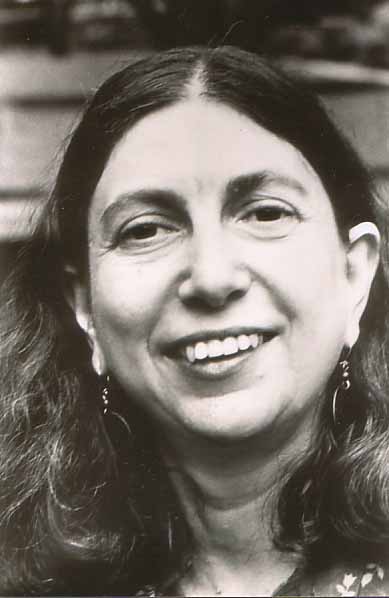LITR 5731: Seminar in American
Multicultural Literature (Immigrant)

Student Poetry Presentation summer 2006
Tuesday,
27 June 2006:
Poetry reader:
Karen Gonzalez
Poem: Enid Dame, “On the Road to Damascus, Maryland,” UA 141

Enid
Dame
From Wikipedia, the
free encyclopedia
Jump to: navigation,
search
Enid
Dame (born in Beaver
Falls, Pennsylvania - died December
25th, 2003) was
an American
poet, fiction
writer, teacher, editor, and publisher. For many years she and her husband, poet
Donald
Lev, lived in Brooklyn and in High Falls, New York, where they edited
and published the literary tabloid Home Planet News. She was on the
faculty of the New Jersey Institute of Technology and Rutgers University in New
Brunswick, where she served as Associate Director of the Writing Program.
Enid
Dame's poems explored themes of urban life, Jewish history and identity, and
political activism. She examined contemporary women's lives in persona poems
that take on the voice of Eve,
Lilith, or
other woman from Jewish tradition. These poems often locate a kernel of feminist
rebellion in familiar Biblical stories.
Major
works include these volumes of poetry:
- On
the Road to Damascus, Maryland,
1980
- Lilith
and Her Demons, 1986
- Anything
You Don't See, 1992
Retrieved from "http://en.wikipedia.org/wiki/Enid_Dame"
Kimmelman,
Burt "The Historical Imperative in Contemporary Jewish American Poetry:
Enid Dame, Michael Heller, and Nikki Stiller"
Shofar: An Interdisciplinary Journal of Jewish Studies - Volume 21, Number 1,
Fall 2002, pp. 103-110
Purdue
University Press
Abstract
The
basic situation of the post-World War Two American Jew is one conditioned by the
Diaspora, the Shoah, and both a religious and otherwise a cultural tradition
marked by letters. American Jewish poets who represent a third generation from
the point of immigration, Enid Dame, Michael Heller, and Nikki Stiller take
history as their backdrop and often as their subject in their poems, as a way in
which to define themselves, to locate themselves within a heterogeneous society
that both beckons to them and threatens to vitiate their traditional identities.
Their voices, peculiarly American and then again peculiarly of New York City
(the point of entry into the new world), are nonetheless Jewish for all their
modernity, but Jewish in a way not seen before the present.
The Lilith Myth
Lilith is believed by some
to have been the first wife of Adam.
- see
many myths about her by looking up Lilith on Google.
Dame’s work is reflected
in the following objectives:
Objective
2 – To
chart the dynamics, variations, and stages of the immigrant narrative.
Recurrent or narrative
cultural themes:
·
A century ago Jews were the model
minority as children of Jewish children became well-educated professionals.
Basic stages of the
Immigrant Narrative
·
Rediscovery or reassertion of
ethnic identity
Objective
5 – To
observe and analyze the effects of immigration and assimilation on cultural
units or identities.
·
Family
·
Gender
·
Community and laws
·
Religion
Special
Literary Objective 9
– To distinguish fictional and non-fictional expressions of the immigrant and
minority narratives.
Poem:
road
to Damascus n.
a religious conversion; a revelation, especially about one’s self; in other
figurative uses, denoting a change in attitude, perspective, or belief. Also road
to Damascus experience.
English
The
"Road to Damascus" is a Biblical
reference to the conversion of a persecutor of Christians
named Saul on the road from Jerusalem
to Damascus
in the Roman
province of Syria
in 36 C.E. According to the Acts
of the Apostles, Jesus
appeared to Saul and he immediately converted to Christianity
and took the name Paul
of Tarsus and became one of the main proselytisers of the new religion. The
"Road to Damascus" is sometimes used outside of Christian contexts to
refer to a conversion or change of heart.
[edit]
Main
article: Paul
of Tarsus
In
the account in the book of Acts, the Pharisee
Saul Paulos of Tarsus is self-described as "a Hebrew
of Hebrews", and as being "extremely zealous for the traditions
of [his] countrymen, and of [his] ancestors". Saul had set out from
Jerusalem for Syrian Damascus, in 36 A.D. with letters from the leaders of the Sanhedrin,
giving Saul the authority to arrest those followers of Jesus
of Nazareth whom he could find living in the city of Damascus. He was to
bring them back to Jerusalem in chains for questioning and possible execution.
Saul had to the best of his ability stamped out Christianity in the city of
Jerusalem; where, according to his own words, he had "laid waste to the
Church, arresting the followers of Jesus, having them thrown into prison, and
trying to get them to blaspheme"
the name of YHWH.
Saul had also distinguished himself during the trial of Saint
Stephen, the first of the official Christian
martyrs, when Saul had "watched over the robes of those who were
stoning Stephen".
[edit]
Paul's
conversion from persecuter
of Christians, at that time called the sect of the Nazarenes
(Acts
24:5), to "Apostle to the Gentiles" (Rom
11:13,Gal
2:8), is recounted in three sections of Acts:
9:3-19a;
22:6-21;
26:12-23.
Wikipedia
The Road to
Damascus, Maryland
On the road to Damascus,
Maryland,
between the trailer camps
and rosebushes
I had a vision
in the back seat
of my parent’s car.
Once again,
it was happening.
I felt myself turning
into someone else.
I wasn’t sure who, yet.
My parents were worried.
Next week I’d be 35
and I still didn’t seem
to know who I was.
At other times
I’d already been:
a New York Jew,
a radical teacher,
an Ethical Culturist,
a barefoot breadbaker,
a nice girl
in knee socks
I was relieved
when they changed the
subject
to where we’d eat lunch
in Damascus.
I sat in the back seat
dreamily
making a list
of new names.
Enid Dame
Question:
Do you see any similarities
between Dame’s narrative and the other immigrant narratives we have read?
|
|
|
|


